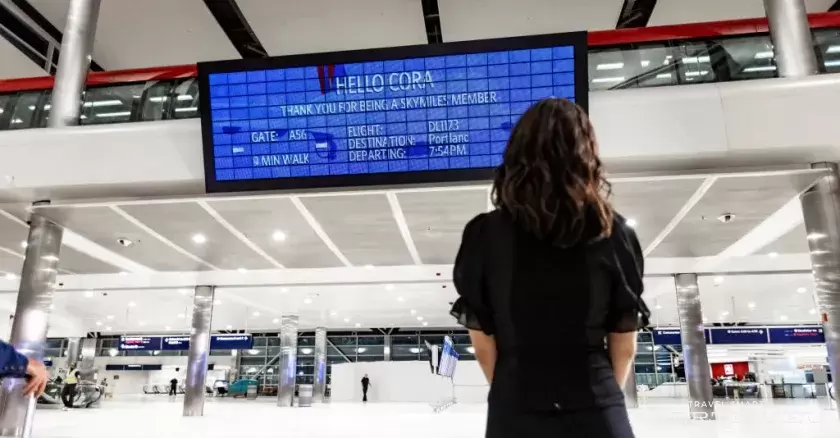
Business travel trends for 2023
Corporate travel budgets are recovering to pre-COVID levels, Morgan Stanley’s new survey finds. See where companies are spending in the year ahead. Business travel trends
After grinding to a near halt during the COVID-19 pandemic, business trips—and profits for hotels and airlines catering to higher-paying corporate clients—are bouncing back even beyond pre-pandemic levels, per a recent survey from Morgan Stanley Research.
What is business travel & why is it popular?
Simply put, business travel is a form of travel typically for business-related activities such as client meetings and external events. It covers different transportation including work or personal cars, public transport (e.g. buses and trains) and flying.
It has become an essential part of business culture to help bring teams together and encourage networking on a global scale.
For example, since the pandemic, many businesses transitioned to a hybrid working pattern which means the typical 9-5 started to disperse.
As a result of this, many employees have had the opportunity to work remotely or even move to a different head office and experience their role within an alternative environment.
Business travel has bridged the gap between seeing your co-workers or clients every day and not seeing them at all.
It’s a popular choice for employees and can offer a work-life balance. It allows them to travel on a regular basis which may not have been deemed necessary before.
Despite higher airfares and room rates, the survey of 100 global corporate travel managers found that many respondents believe their company’s travel expenditures are already back to pre-pandemic levels and will continue to grow. The biggest demand is coming from small companies, which means lower-cost airlines may benefit more than their bigger peers.
“Travel budgets are expected to see a noticeable improvement in 2022, with 2023 nearly back to ‘normal,’” says Ravi Shanker, an equity analyst covering North American transportation. “Most interesting is that nearly half of the respondents expect 2023 budgets to increase versus 2019 overall. And of those that expect an increase in budgets, the majority believe 2023 budgets will be between 6% to 10% higher than 2019.”
Overall travel budgets show an improvement over previous surveys, with 2023 budgets expected to be 98% of 2019 levels on average

Survey Highlights
- Smaller companies lead the demand for corporate travel. More than two-thirds (68%) of companies with under $1 billion in annual revenue expect travel budgets to increase next year, versus just 41% of companies with annual revenues over $16 billion. Similarly, 32% of smaller companies said travel budgets had returned to pre-pandemic levels compared with 23% of big firms. “This trend could likely favor low-cost carriers, as smaller enterprises tend to be more localized and require less long-haul travel,” says Shanker. “However, the legacy carriers with strong corporate exposure should see gains as well.”
Nearly a quarter of both large and small companies say their firms are already back to pre-COVID travel levels, and 34% anticipate a full recovery by the end of 2023.

- Airfares are higher, but that’s not a drag on bookings. On average, corporate airfares are expected to be about 9% higher than pre-pandemic prices. “Clearly the expected increase in corporate airfares is not having a major impact on corporate travel as passenger volume is expected to be basically flat versus 2019,” says Shanker.
- Room rates will continue to rise, though not as fast as they have recently. As of this October, market room rates had spiked 20% to 25% over 2019. Next year they will rise even more, though by an average of just 8%, say respondents (9% in the U.S. and U.K.; 5% to 6% in Latin America, Asia and Africa).
- Hotels face economic and competitive headwinds. While overall travel budgets are growing, companies are cutting costs by trading down when it comes to accommodations. (Historically, budget hotels outperform upscale lodging in tough economic times.) Alternative sources of accommodation also threaten traditional hotels, with 31% of respondents saying they intend to use short-term rental services in the next year.
- Virtual meetings aren’t going away. Almost 18% of corporate travel will be replaced with virtual meetings, falling slightly to 17% in 2024, suggesting a degree of permanence in the shift with companies recognizing the benefits of virtual meetings ranging from cost savings to lower carbon footprints. Expect companies providing collaboration software to gain from this shift.
4 Emerging Business Travel Trends to Expect in 2023
1. Biometrics will make travel more efficient
Biometrics, or unique physical characteristics such as fingerprints, are now common in payment apps such as Apple Pay and Google Pay. Travelers can expect increased opportunities to use these and other touchless payment systems for travel options like in-flight purchases, hotel upgrades, and train tickets.
COVID-19 forced airlines and airports to reduce touchpoints so biometric technology was readily adopted. A bonus effect is an operational efficiency and time savings for the traveler.
- Biometric check-in and baggage drop systems were piloted in Chicago’s O’Hare and New York’s LaGuardia airports, cutting travelers’ time spent by 30%.
- Los Angeles International Airport’s $1.7 billion terminal expansion uses contactless boarding gates. It can board 400 people in 20 minutes, half of the normal boarding time.
- International business travelers will see immigration and border control speed up at 27 U.S. airports with the use of facial recognition technology.
- Airports will increasingly use fingerprint and retinal scanning technologies for security.
2. Blended travel continues to increase
Bleisure travel, the combining of business and leisure travel, has been a business travel trend for several years and there is no indication that it’s going away. Most employees now see business travel as a perk and an enriching experience and enjoy extending for personal motives.
- Younger members of the workforce often want to advantage of a business trip by adding on some vacation time and exploring the new destination’s sights, activities, and food.
- More than half of international business travelers indicated they are willing to extend their trips for leisure activities.
- Many business travelers bring family along, contributing to their work/life balance and well-being.
3. Work-from-anywhere policies become normalized
Office shutdowns during the pandemic showed many businesses that it is possible to keep the company functioning while people work remotely. As a result, many of those adjusted their policies and now allow business travelers to become digital nomads. Not all job positions are suited to remote work, but for those that are, countries such as Costa Rica, Georgia, Croatia, Iceland, and Germany created programs and incentives to attract digital workers to make a temporary base there for a month or more.
Another development stemming from remote workforces is the trend for team business travel. Since employees don’t have the proverbial “water cooler” office experience, team meetings and retreats allow colleagues to bond and strengthen relationships. Experts expect a significant increase in team travel programs because they effectively motivate teams, improve employee satisfaction, strengthen company loyalty, and unlock creativity.
4. Sustainability influences business travel trends
It’s no secret that travel, air travel emissions, in particular, have a large impact on the environment. It’s also a fact that travel generates growth and is key to building and maintaining business relationships. Therefore, sustainability is one of the hottest topics trending in business travel.
Global Business Travel Association (GBTA) found that 89% of companies are making sustainability a priority. While there are many ways to effect change, it begins with assessing the true carbon costs of travel, creating a strategy, and educating travelers on the environmental effects of travel.
Some sustainability trends in business travel include:
- Updating corporate travel policies by increasing traveler options to balance business costs with employee well-being and sustainability. For example, offering more flexibility in property and rate options, allows employees to align their own needs with company policies.
- Companies prioritizing green hotels in corporate online booking tools and making sustainability-related information a prerequisite for preferred supplier status.
- Providing education for travelers on best practices and technologies that help reduce their carbon footprint.
- Travelers choosing direct flights, using trains when possible, and choosing the most sustainable hotels.
- Travelers packing lighter or even suitcase-free to reduce the airline’s load factor. For example, consider renting golf clubs instead of taking your own with you.
- Organizations and individuals purchasing carbon offsets to compensate for the emissions their travel causes.
The advantages of business travel
Planning face-to-face meetings when it’s necessary
Sometimes a video conferencing call doesn’t quite have the same effect as an in-person meeting.
This is particularly important for remote-based companies that have missed out on getting to know their colleagues on a personal level.
Now, many organisations spend time preparing meetings such as business briefings or KPI planning. This allows employees to meet their co-workers on a regular basis and build greater connections.
Employee satisfaction increases
Now, more than ever, employees want to start travelling for business again. Especially, if it was a part of their routine before.
Business travel offers an opportunity to be in a different environment and can help introduce new ways of thinking.
It can help a business build a more empathetic workforce by connecting with new people and understanding different cultures.
Offers growth opportunities for workers
Travelling for business can improve your employees’ confidence and communication skills. It is a good way of finding out whether they’d be interested in other suitable positions or as a way of developing their existing skills.
This type of opportunity can encourage an employee to see a future with the business.








